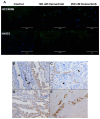Transcriptomic Analysis Reveals Early Alterations Associated with Intrinsic Resistance to Targeted Therapy in Lung Adenocarcinoma Cell Lines
- PMID: 39001552
- PMCID: PMC11240825
- DOI: 10.3390/cancers16132490
Transcriptomic Analysis Reveals Early Alterations Associated with Intrinsic Resistance to Targeted Therapy in Lung Adenocarcinoma Cell Lines
Abstract
Lung adenocarcinoma is the most prevalent form of lung cancer, and drug resistance poses a significant obstacle in its treatment. This study aimed to investigate the overexpression of long non-coding RNAs (lncRNAs) as a mechanism that promotes intrinsic resistance in tumor cells from the onset of treatment. Drug-tolerant persister (DTP) cells are a subset of cancer cells that survive and proliferate after exposure to therapeutic drugs, making them an essential object of study in cancer treatment. The molecular mechanisms underlying DTP cell survival are not fully understood; however, long non-coding RNAs (lncRNAs) have been proposed to play a crucial role. DTP cells from lung adenocarcinoma cell lines were obtained after single exposure to tyrosine kinase inhibitors (TKIs; erlotinib or osimertinib). After establishing DTP cells, RNA sequencing was performed to investigate the differential expression of the lncRNAs. Some lncRNAs and one mRNA were overexpressed in DTP cells. The clinical relevance of lncRNAs was evaluated in a cohort of patients with lung adenocarcinoma from The Cancer Genome Atlas (TCGA). RT-qPCR validated the overexpression of lncRNAs and mRNA in the residual DTP cells and LUAD biopsies. Knockdown of these lncRNAs increases the sensitivity of DTP cells to therapeutic drugs. This study provides an opportunity to investigate the involvement of lncRNAs in the genetic and epigenetic mechanisms that underlie intrinsic resistance. The identified lncRNAs and CD74 mRNA may serve as potential prognostic markers or therapeutic targets to improve the overall survival (OS) of patients with lung cancer.
Keywords: CD74; drug-tolerant persister (DTP) cells; erlotinib; intrinsic resistance; lung adenocarcinoma; osimertinib; senescent cells; tyrosine kinase inhibitors (TKIs).
Conflict of interest statement
The authors declare no conflicts of interest.
Figures







Similar articles
-
Transcriptional signature of early cisplatin drug-tolerant persister cells in lung adenocarcinoma.Front Oncol. 2023 Oct 17;13:1208403. doi: 10.3389/fonc.2023.1208403. eCollection 2023. Front Oncol. 2023. PMID: 37916165 Free PMC article.
-
A prognostic model of drug tolerant persister-related genes in lung adenocarcinoma based on single cell and bulk RNA sequencing data.Heliyon. 2023 Oct 5;9(11):e20708. doi: 10.1016/j.heliyon.2023.e20708. eCollection 2023 Nov. Heliyon. 2023. PMID: 37920509 Free PMC article.
-
Single-Cell Analysis Reveals Transcriptomic Features of Drug-Tolerant Persisters and Stromal Adaptation in a Patient-Derived EGFR-Mutated Lung Adenocarcinoma Xenograft Model.J Thorac Oncol. 2023 Apr;18(4):499-515. doi: 10.1016/j.jtho.2022.12.003. Epub 2022 Dec 16. J Thorac Oncol. 2023. PMID: 36535627
-
Mechanism of Drug Tolerant Persister Cancer Cells: The Landscape and Clinical Implication for Therapy.J Thorac Oncol. 2021 Nov;16(11):1798-1809. doi: 10.1016/j.jtho.2021.07.017. Epub 2021 Aug 3. J Thorac Oncol. 2021. PMID: 34352380 Review.
-
Differential expression and clinical significance of long non-coding RNAs in the development and progression of lung adenocarcinoma.Front Oncol. 2024 Jun 6;14:1411672. doi: 10.3389/fonc.2024.1411672. eCollection 2024. Front Oncol. 2024. PMID: 38912059 Free PMC article. Review.
Cited by
-
Drug-tolerant persister cells in acute myeloid leukemia: pressing challenge and promising new strategies for treatment.Front Med (Lausanne). 2025 May 14;12:1586552. doi: 10.3389/fmed.2025.1586552. eCollection 2025. Front Med (Lausanne). 2025. PMID: 40443513 Free PMC article. Review.
References
-
- Nie N., Li J., Zhang J., Dai J., Liu Z., Ding Z., Wang Y., Zhu M., Hu C., Han R., et al. First-Line Osimertinib in Patients with EGFR-Mutated Non-Small Cell Lung Cancer: Effectiveness, Resistance Mechanisms, and Prognosis of Different Subsequent Treatments. Clin. Med. Insights Oncol. 2022;16:117955492211347. doi: 10.1177/11795549221134735. - DOI - PMC - PubMed
Grants and funding
LinkOut - more resources
Full Text Sources

